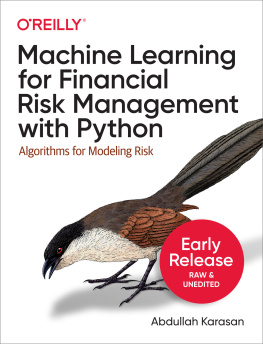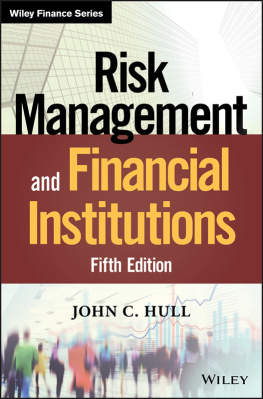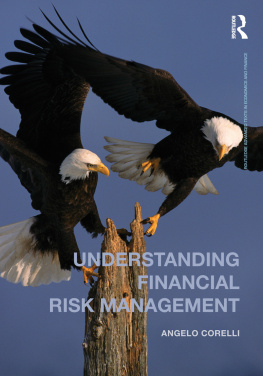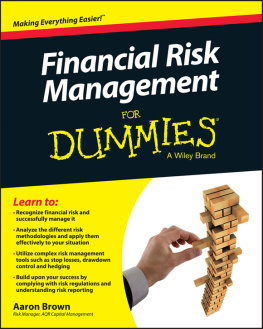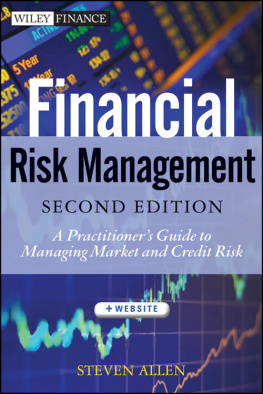Contents
.
Founded in 1807, John Wiley & Sons is the oldest independent publishing company in the United States. With offices in North America, Europe, Australia and Asia, Wiley is globally committed to developing and marketing print and electronic products and services for our customers professional and personal knowledge and understanding.
The Wiley Finance series contains books written specifically for finance and investment professionals as well as sophisticated individual investors and their financial advisors. Book topics range from portfolio management to e-commerce, risk management, financial engineering, valuation and financial instrument analysis, as well as much more.
For a list of available titles, visit our Web site at www.WileyFinance.com .

Copyright 2013 by Max Wong Chan Yue
Published by John Wiley & Sons Singapore Pte. Ltd.
1 Fusionopolis Walk, #07-01, Solaris South Tower, Singapore 138628
All rights reserved.
First edition published by Immanuel Consulting Pte. Ltd. in 2011
No part of this publication may be reproduced, stored in a retrieval system, or transmitted in any form or by any means, electronic, mechanical, photocopying, recording, scanning, or otherwise, except as expressly permitted by law, without either the prior written permission of the Publisher, or authorization through payment of the appropriate photocopy fee to the Copyright Clearance Center. Requests for permission should be addressed to the Publisher, John Wiley & Sons Singapore Pte. Ltd., 1 Fusionopolis Walk, #07-01, Solaris South Tower, Singapore 138628, tel: 6566438000, fax: 6566438008, e-mail: .
Limit of Liability/Disclaimer of Warranty: While the publisher, author and contributors have used their best efforts in preparing this book, they make no representations or warranties with respect to the accuracy or completeness of the contents of this book and specifically disclaim any implied warranties of merchantability or fitness for a particular purpose. No warranty may be created or extended by sales representatives or written sales materials. The advice and strategies contained herein may not be suitable for your situation. You should consult with a professional where appropriate. Neither the publisher, authors, or contributors shall be liable for any loss of profit or any other commercial damages, including but not limited to special, incidental, consequential, or other damages.
Excel is a registered trademark of the Microsoft Corporation.
RiskMetrics is a registered trademark of RiskMetrics Group.
CreditMetrics is a registered trademark of RiskMetrics Solutions.
CreditRisk+ is a registered trademark of Credit Suisse Group.
Bloomberg is a registered trademark of Bloomberg L.P.
CrashMetrics is a registered trademark of Paul Wilmott and Philip Hua.
BUVAR is a registered trademark of Wong Chan Yue
Other Wiley Editorial Offices
John Wiley & Sons, 111 River Street, Hoboken, NJ 07030, USA
John Wiley & Sons, The Atrium, Southern Gate, Chichester, West Sussex, P019 8SQ, United Kingdom
John Wiley & Sons (Canada) Ltd., 5353 Dundas Street West, Suite 400, Toronto, Ontario, M9B 6HB, Canada
John Wiley & Sons Australia Ltd., 42 McDougall Street, Milton, Queensland 4064, Australia
Wiley-VCH, Boschstrasse 12, D-69469 Weinheim, Germany
Library of Congress Cataloging-in-Publication Data
ISBN 978-1-118-55034-2 (Hardcover)
ISBN 978-1-118-55035-9 (ePDF)
ISBN 978-1-118-55036-6 (Mobi)
ISBN 978-1-118-55037-3 (ePub)
To my heavenly Father, who gave me this assignment
About the Author
Max Wong is a specialist in the area of risk modeling and Basel III. He started his career as a derivatives consultant at Credit Suisse First Boston in 1996. During the Asian crisis in 1998, he traded index futures at the open-outcry floor of SIMEX (now SGX). From 2003 to 2011, he worked for Standard Chartered Bank as a risk manager and senior quant. He is currently head of VaR model testing at the Royal Bank of Scotland.
He has published papers on VaR models and Basel capital, recently looking at innovative ways to model risk more effectively during crises and to deal with the issues of procyclicality and Black Swan events in our financial system. He has spoken on the subject at various conferences and seminars.
He holds a BSc in physics from the University of Malaya (1994) and an MSc in financial engineering from the National University of Singapore (2004). He is an adjunct at Singapore Management University, a member of the editorial board of the Journal of Risk Management in Financial Institutions , and a member of the steering committee of PRMIA Singapore chapter.
Foreword
Financial markets are all about risk management. Banking and capital markets activities throw up all manner of risk exposures as a matter of course, and these need to be managed accordingly such that stakeholders are comfortable. Market risk traditionally referred to risks arising from a change in market factors, and when we say risk we mean risk to the profit and loss account or to revenues. These market factors might be interest rates, foreign currency rates, customer default rates, and so on. Managers of a financial institution should expect to have some idea of the extent of their risk to these dynamic factors at any one time, so that they can undertake management action to mitigate or minimize the risk exposure. This is Finance 101 and is as old as commerce and money itself.
Measuring market exposure has always been a combination of certain methods that might be called scientific and others that might be described as application of learned judgment. I have always been a fan of modified duration for interest rate risk and I still recommend it. Of course it has its flaws, which estimation method doesnt? But when Value-at-Risk (VaR) was first presented to the world it appeared to promise to make the risk managers job easier, because it seemed to offer a more accurate estimate of risk exposure at any time. And the latter was all it ever was, or claimed to be: an estimation of risk exposure. A measure of risk, no better and no worse than the competence of the person who was making use of the calculated numbers.
Unfortunately, in some quarters VaR was viewed as being somehow a substitute for risk management itself. It didnt help that the assumptions underpinning every single methodology for calculating VaR were never widely understood, at least not at the senior executive level, which made explaining losses that exceeded the VaR estimate even more difficult than usual. In 2012 JPMorgan announced losses of up to $9 billion in a portfolio of corporate credits that were managed by its London-based chief investment office. Depending on which media report one follows, the VaR number reported for the bank as a whole the day before the announcement was alleged to be between 1 percent and 10 percent of this value. Is there any point in going to the trouble of calculating this estimate if at any time it can be demonstrated to be so completely off the mark?
The short answer is yes and no. VaR is a tool, nothing more nor less, and like all tools must be used within its limitations. One could argue that a bank the size and complexity of JPMorgan is going to struggle to ever get a meaningful estimate of its true risk exposure under all marker conditions, but therein lies the value and the worthlessness of any statistical measure like VaR: it is reasonable for some, indeed most, of the time but when it does get out of kilter with market movements the difference could be huge (an order of magnitude of up to 100 times out, if some recent headlines are to be believed). It reminds one of the apocryphal story of the statistician who drowned in a lake that had an average depth of six inches.


